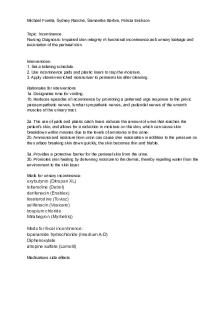Urinary Incontinence Nursing Diagnosis PDF

| Title | Urinary Incontinence Nursing Diagnosis |
|---|---|
| Author | Michelle Ford |
| Course | med surg |
| Institution | Chamberlain University |
| Pages | 3 |
| File Size | 86.3 KB |
| File Type | |
| Total Downloads | 18 |
| Total Views | 148 |
Summary
Nursing Diagnosis and plan of care for Patient with Urinary Incontinence...
Description
Michael Funtila, Sydney Rasche, Samantha Barbre, Felicia Erickson Topic: Incontinence Nursing Diagnosis: Impaired skin integrity r/t functional incontinence aeb urinary leakage and excoriation of the perineal skin.
Interventions: 1. Set a toileting schedule. 2. Use incontinence pads and plastic liners to trap the moisture. 3. Apply vitamin-enriched moisturizer to perineal skin after cleaning. Rationales for interventions 1a. Designates time for voiding. 1b. Reduces episodes of incontinence by promoting a patterned urge response to the pelvic parasympathetic nerves, lumbar sympathetic nerves, and pudendal nerves of the smooth muscles of the urinary tract. 2a. The use of pads and plastic catch liners reduces the amount of urine that reaches the patient's skin, and allows for a reduction in moisture on the skin, which can cause skin breakdown within minutes due to the levels of ammonia in the urine. 2b. Ammonia and moisture from ursin can cause skin maceration in addition to the pressure on the surface breaking skin down quickly, the skin becomes thin and friable. 3a. Provides a protective barrier for the perineal skin from the urine. 3b. Promotes skin healing by delivering moisture to the dermis, thereby repelling water from the environment to the skin layer. Meds for urinary incontinence:
oxybutynin (Ditropan XL) tolterodine (Detrol) darifenacin (Enablex) fesoterodine (Toviaz) solifenacin (Vesicare) trospium chloride Mirabegron (Myrbetriq) Meds for fecal incontinence: loperamide hydrochloride (Imodium A-D) Diphenoxylate atropine sulfate (Lomotil) Medications side effects
Michael Funtila, Sydney Rasche, Samantha Barbre, Felicia Erickson
oxybutynin (Ditropan XL)- Dry mouth, drowsiness, headache, dizziness, nausea, vomiting, upset stomach, stomach pain, constipation, diarrhea, blurred vision, dry eyes, unusual taste in mouth, dry/flushed skin, stuffy nose, and cough. tolterodine (Detrol)- Dry mouth, dry eyes, headache, constipation, stomach upset/pain, dizziness, drowsiness, tiredness, or blurred vision. darifenacin (Enablex)- Dry mouth, constipation, nausea, stomach upset, stomach pain, blurred vision, dry eyes, dizziness, or weakness. fesoterodine (Toviaz)- Bladder pain, bloating, swelling, dysuria, difficulty breathing. solifenacin (Vesicare)- Dry mouth, constipation, stomach pain, upset stomach, vomiting, heartburn, dry eyes, blurred vision. trospium chloride- Dry mouth, dry throat, constipation, upset stomach, gas, headache, dry eyes, dizziness, blurred vision. Mirabegron (Myrbetriq)- Nausea, constipation, UTI, headache, dizziness, tachycardia. loperamide hydrochloride (Imodium A-D)- Constipation, dizziness, drowsiness, nausea, stomach cramps. Diphenoxylate- Drowsiness, dizziness, headache, malaise, confusion, dry mouth, nauseous, vomiting, upset stomach. atropine sulfate (Lomotil)- Dry mouth, blurred vision, photosensitivity, dizziness, nausea, skin rash.
Signs and symptoms -leaking urine when coughing, sneezing, laughing or exercising -feeling sudden uncontrollable urges to urinate -frequent urination -waking up many times at night to urinate -urinating during sleep Lab values/Diagnostics: **no specific lab values** -Urinalysis can help identify factors contributing to transient UI -Postvoid residual (PVR): this is obtained by asking the patient to void, followed by catheterization or use of a bladder ultrasound; this amount will show the urine left over in the bladder after urination -Bladder stress test -Ultrasound or x-rays Patient outcomes: - Patients will have a reduction in skin breakdown and pressure injuries. - Patient will remain dry and clean from urine - Patient will establish a routine bathroom schedule and change pads within 10 minutes of being soiled.
Michael Funtila, Sydney Rasche, Samantha Barbre, Felicia Erickson -
Patient will have understanding of teaching related to the use of pads, fluid intake during the day and reduction of fluids before bed. Patient will understand the related factors that can contribute to incontinence.
References:
What is the role of the parasympathetic nervous system in the neuroanatomy of neurogenic bladder? (2021, May 11). Www.medscape.com. https://www.medscape.com/answers/453539-45918/what-is-the-role-of-theparasympathetic-nervous-system-in-the-neuroanatomy-of-neurogenic-bladder Yoshimura, N., & Chancellor, M. B. (2003). Neurophysiology of Lower Urinary Tract Function and Dysfunction. Reviews in Urology, 5(Suppl 8), S3–S10. https://www.ncbi.nlm.nih.gov/pmc/articles/PMC1502389/#:~:text=in%20urge %20incontinence.-...
Similar Free PDFs

Nursing diagnosis
- 2 Pages

Nursing Diagnosis
- 5 Pages

Nanda Nursing Diagnosis
- 7 Pages

Nanda Nursing Diagnosis list
- 16 Pages

Nursing diagnosis by maslows
- 9 Pages

Nursing Diagnosis FVD
- 1 Pages

Nursing Diagnosis for MIU
- 1 Pages

Nursing Diagnosis for Sepsis
- 8 Pages

Chapter 7 Nursing Diagnosis
- 1 Pages

Wizard of OZ Nursing Diagnosis
- 4 Pages
Popular Institutions
- Tinajero National High School - Annex
- Politeknik Caltex Riau
- Yokohama City University
- SGT University
- University of Al-Qadisiyah
- Divine Word College of Vigan
- Techniek College Rotterdam
- Universidade de Santiago
- Universiti Teknologi MARA Cawangan Johor Kampus Pasir Gudang
- Poltekkes Kemenkes Yogyakarta
- Baguio City National High School
- Colegio san marcos
- preparatoria uno
- Centro de Bachillerato Tecnológico Industrial y de Servicios No. 107
- Dalian Maritime University
- Quang Trung Secondary School
- Colegio Tecnológico en Informática
- Corporación Regional de Educación Superior
- Grupo CEDVA
- Dar Al Uloom University
- Centro de Estudios Preuniversitarios de la Universidad Nacional de Ingeniería
- 上智大学
- Aakash International School, Nuna Majara
- San Felipe Neri Catholic School
- Kang Chiao International School - New Taipei City
- Misamis Occidental National High School
- Institución Educativa Escuela Normal Juan Ladrilleros
- Kolehiyo ng Pantukan
- Batanes State College
- Instituto Continental
- Sekolah Menengah Kejuruan Kesehatan Kaltara (Tarakan)
- Colegio de La Inmaculada Concepcion - Cebu





